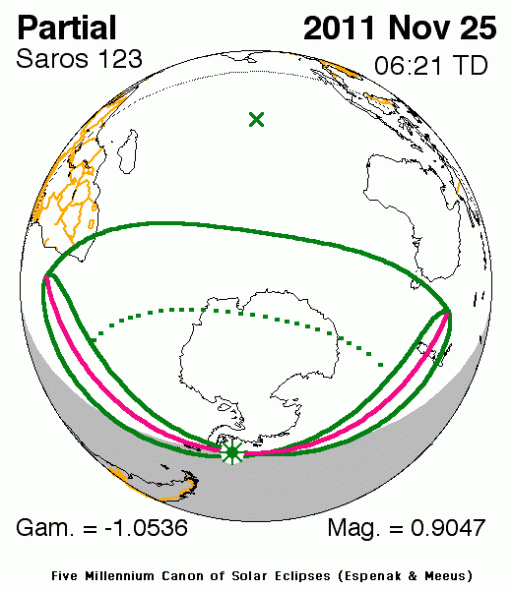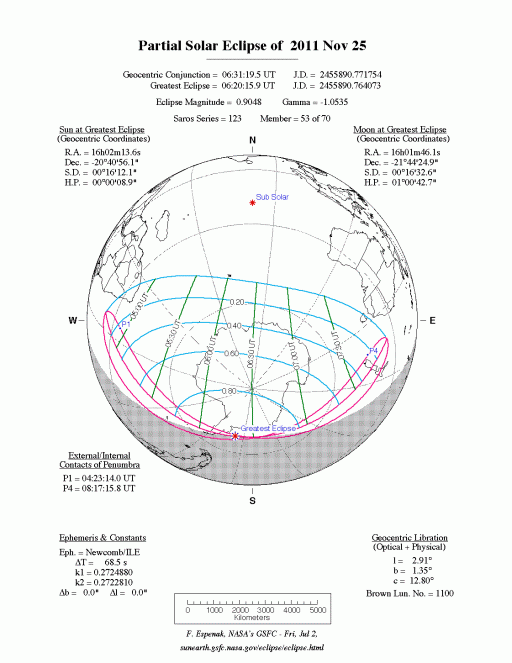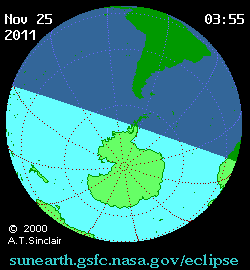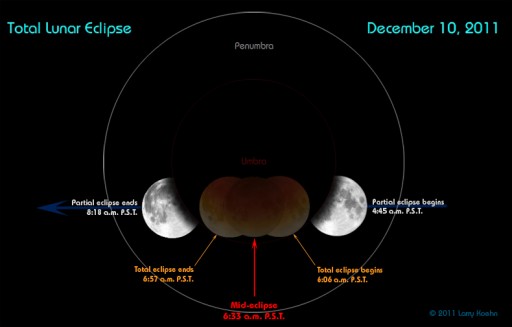Antarctic solar eclipse on November 25th
![Antarctic solar eclipse on November 25th Tweet Tweet On Nov. 25th the Moon will pass in front of the sun, slightly off-center, producing a partial solar eclipse visible from Antarctica, Tasmania, and parts of South Africa and New Zealand. Maximum coverage occurs about 100 miles off the coast of Antarctica where the sun will appear to be a slender 9% crescent. (SpaceWeather) [animated map] This is the fourth and final partial eclipse of the Sun for this year. Again, this eclipse...](http://thewatchers.adorraeli.com/wp-content/uploads/2011/11/eclipse-512x250.jpg)
On Nov. 25th the Moon will pass in front of the sun, slightly off-center, producing a partial solar eclipse visible from Antarctica, Tasmania, and parts of South Africa and New Zealand. Maximum coverage occurs about 100 miles off the coast of Antarctica where the sun will appear to be a slender 9% crescent. (SpaceWeather)
This is the fourth and final partial eclipse of the Sun for this year. Again, this eclipse is mostly in a remote area of the world with the best show occurring in and around Antartica. The greatest eclipse is about 100 miles off the coast of Antartica with the Moon obscuring 90.5% of the Sun. (Shadow&Substance)
At the instant of greatest eclipse (06:20:17 UT) the eclipse magnitude is 0.905, making it the largest partial eclipse of the year. At that time, the lunar shadow axis will pass just 330 km above Earth’s surface near the coast of Antarctica.
This is the 53rd eclipse of Saros 123. The family began with 6 partial eclipses from the years 1074 to 1164. By the time the series ends in 2318, it will have produced 70 eclipses in the following order: 6 partial, 27 annular, 3 hybrid, 14 total, and 20 partial eclipses. Complete details for Saros 123 can be found here.
The same night Jupiter’s icy, enigmatic moon Europa crosses onto the face of the planet at 9:45 p.m. EST, then exits at 12:10 a.m. EST. Europa’s tiny black shadow crosses Jupiter from 11:08 p.m. to 1:34 a.m. EST.
Few weeks after, on December 10 total lunar eclipse is about to happen. This total eclipse of the moon should mostly be seen from the pacific states on westward. San Franciscans can get to see it if they have a clear view of the western horizon.
Catalog of Solar Eclipses: 2001 to 2100












No comments